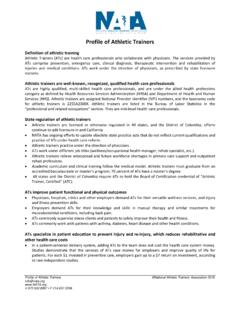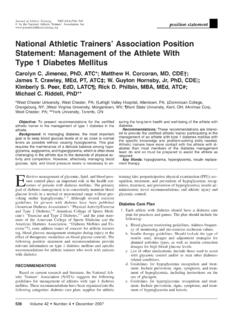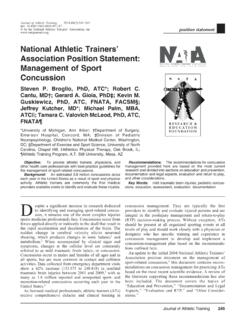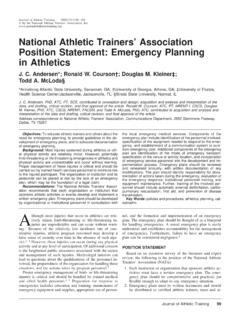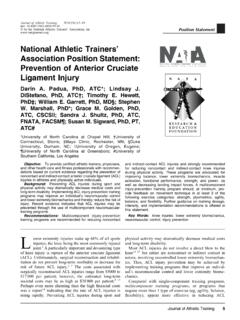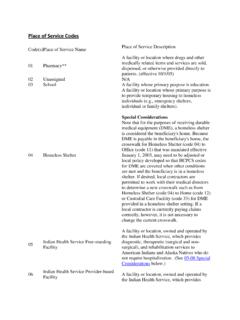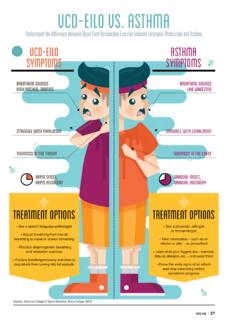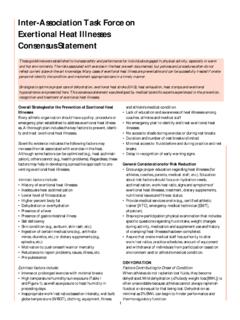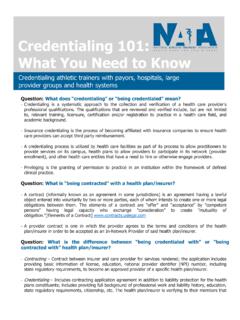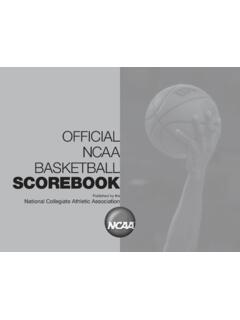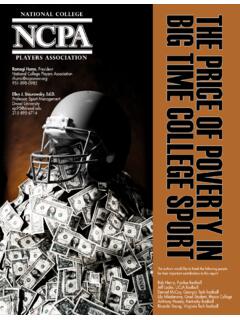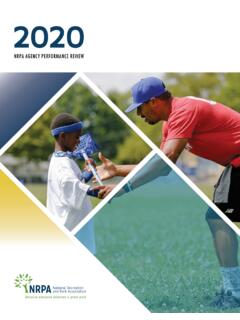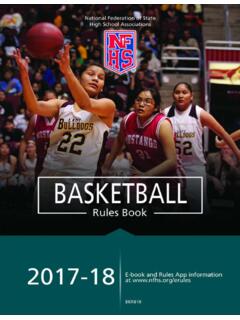Transcription of National Athletic Trainers’ Association Position Statement ...
1 Journal of Athletic Training 2013;48(4):528 545. doi: by the National Athletic Trainers' Association , Inc Position Statement National Athletic Trainers'. Association Position Statement : Conservative Management and Prevention of Ankle Sprains in Athletes Thomas W. Kaminski, PhD, ATC, FNATA, FACSM*; Jay Hertel, PhD, ATC, FNATA, FACSM ; Ned Amendola, MD ; Carrie L. Docherty, PhD, ATC, FNATA ; Michael G. Dolan, MA, ATC||; J. Ty Hopkins, PhD, ATC, FNATA ; Eric Nussbaum, MEd, ATC#; Wendy Poppy, MS, PT, ATC ; Doug Richie, DPM**. *University of Delaware, Newark; University of Virginia, Charlottesville; University of Iowa, Iowa City; Indiana University, Bloomington; ||Canisius College, Buffalo, NY; Brigham Young University, Provo, UT; #Freehold (New Jersey) Regional High School District; **California School of Podiatric Medicine, Samuel Merritt University, Oakland Objective: To present recommendations for Athletic trainers syndesmotic ankle sprains and chronic ankle instability are and other allied health care professionals in the conservative presented.
2 Management and prevention of ankle sprains in athletes. Recommendations: The recommendations included in this Background: Because ankle sprains are a common and Position Statement are intended to provide Athletic trainers and often disabling injury in athletes, Athletic trainers and other other sports health care professionals with guidelines and sports health care professionals must be able to implement the criteria to deliver the best health care possible for the prevention most current and evidence-supported treatment strategies to and management of ankle sprains. An endorsement as to best ensure safe and rapid return to play. Equally important is practice is made whenever evidence supporting the recommen- initiating preventive measures to mitigate both first-time sprains dation is available.
3 And the chance of reinjury. Therefore, considerations for appropriate preventive measures (including taping and bracing), Key Words: ankle instability, syndesmotic ankle sprains, initial assessment, both short- and long-term management cryotherapy, immobilization, compression, sensorimotor system, strategies, return-to-play guidelines, and recommendations for taping, bracing A. nkle sprains are common injuries that affect Most ankle sprains result from damage to the lateral athletes of all ages and in all sporting activities. ligament structures (anterior talo bular, calcaneo bular, An estimated 28 000 ankle injuries occur in the and posterior talo bular ligaments) after a stress on an United States each These injuries translate into an inverted and plantar- exed (supinated) Sprains are enormous burden on the health care industry and result in usually graded on the basis of severity and range from mild millions of dollars spent on treatment each year.
4 In sport, (grade I) to severe (grade III): The grading scale is a ankle injuries are the most common injury,2 with some spectrum from no signi cant structural injury to complete estimates attributing upward of 45% of all Athletic injuries rupture of the ligamentous structures. Landing from jumps, to ankle In their systematic review, Fong et al2 landing or stepping on another athlete's foot, trauma at heel noted that the incidence rates of ankle injury and sprain are strike during running, and stressing the foot while in a xed highest in eld hockey, followed by volleyball, football, Position are common mechanisms for ankle In a basketball, cheerleading, ice hockey, lacrosse, soccer, comprehensive review, Beynnon et al4 evaluated intrinsic rugby, track and eld, gymnastics, and softball.
5 And extrinsic risk factors for ankle sprains in athletes and 528 Volume 48 Number 4 August 2013. Table. Strength of Recommendation Taxonomy (SORT)a Abbreviations: RCT indicates randomized controlled trial; SR, systematic review. a In general, only key recommendations for readers require a grade of the Strength of Recommendation.'' Recommendations should be based on the highest quality evidence available. For example, vitamin E was found in some cohort studies (level 2 study quality) to have a benefit for cardiovascular protection, but good-quality randomized trials (level 1) have not confirmed this effect. Therefore, it is preferable to base clinical recommendations in a manuscript on the level 1 studies.
6 Reprinted with permission from Strength of Recommendation Taxonomy (SORT): A Patient-Centered Approach to Grading Evidence in the Medical Literature,'' February 1, 2004, American Family Physician. Copyright 2004 American Academy of Family Physicians. All Rights Reserved. b Patient-oriented evidence measures outcomes that matter to patients: morbidity, mortality, symptom improvement, cost reduction, and quality of life. Disease-oriented evidence measures intermediate, physiologic, or surrogate end points that may or may not reflect improvements in patient outcomes ( , blood pressure, blood chemistry, physiologic function, pathologic findings). c High-quality diagnostic cohort study: cohort design, adequate size, adequate spectrum of patients, blinding, and a consistent, well-defined reference standard.
7 D High-quality RTC: allocation concealed, blinding if possible, intention-to-treat analysis, adequate statistical power, adequate follow-up (greater than 80%). e In an all-or-none study, the treatment causes a dramatic change in outcomes, such as antibiotics for meningitis or surgery for appendicitis, which precludes study in a controlled trial. concluded that the only consistent risk factor identi ed Position Statement is to present recommendations for across original research studies was a previous history of certi ed Athletic trainers and other allied health care ankle sprain. professionals in the conservative management and preven- Despite the frequency of ankle sprains in athletes, the tion of ankle sprains in athletes.
8 Our recommendations are outcomes associated with these injuries are less than reinforced by relevant scholarly evidence currently avail- optimal. Individuals who sustain initial ankle sprains able in peer-reviewed publications and graded according to demonstrate high recurrence rates, prolonged symptoms, the Strength of Recommendation Taxonomy (Table).5. diminished quality of life, reduced physical activity levels across the lifespan, a propensity to develop chronic ankle Recommendations instability, and an increased risk for ankle The National Athletic Trainers' Association (NATA). Managing these injuries appropriately is clearly problem- suggests the following guidelines in the management and atic for sports health care professionals.
9 The purpose of this prevention of ankle sprains in the Athletic population. Journal of Athletic Training 529. Diagnosis 17. Nonsteroidal anti-in ammatory drugs, administered oral- ly or topically, reduce pain and swelling and improve 1. The patient's history, including the mechanism of injury short-term function after ankle 29 Evidence and past injuries and clinician observation and palpation, Category: A. can provide important insights into the anatomical 18. Functional rehabilitation is more effective than immobi- structures that may be injured in a patient suspected of lization in managing grade I and II ankle ,31. having an ankle sprain. However, the severity of injury Evidence Category: A.
10 May be dif cult to determine. Evidence Category: C 19. Grade III sprains should be immobilized for at least 10. 2. Assessment of active, passive, and resistive range of days with a rigid stirrup brace or below-knee cast and motion (ROM) about the ankle can provide insight into then controlled therapeutic exercise ,32 Evi- injury to ligaments, muscles, tendons, and nerves. dence Category: B. Evidence Category: C 20. Electrical stimulation can be used as an adjunct to 3. Special tests to assess injury to the lateral ankle minimize swelling during the acute phase of ,34. ligaments, such as the anterior drawer and inversion talar Evidence Category: C. tilt tests, performed soon after injury and before joint 21.
